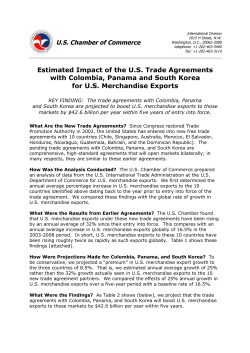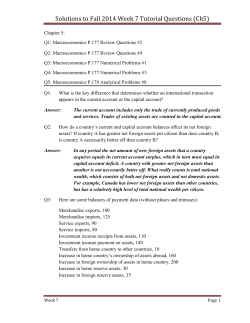
International Trade: Theory and Policy Lab Session: Trade Data
Department of Economics - University of Roma Tre Academic year: 2014-2015 International Trade: Theory and Policy Lab Session: Trade Data Instructors: Prof. Silvia Nenci silvia.nenci@uniroma3.it Prof. Luca Salvatici luca.salvatici@uniroma3.it Lecture topics There exists a large variety of data sources for trade data: Standard Trade databases Aggregated trade data: • IMF – DOTS Disaggregated trade data: • WITS - UN Comtrade • Eurostat- Comext Firm level • Several dbs (mainly country based) New data on trade in value added • WIOD • TiVA Aggregated trade data http://data.imf.org/?sk=9D6028D4-F14A-464C-A2F259B2CD424B85 The IMF’s Direction of Trade Statistics (DOTS) is the primary source of aggregated bilateral trade data (value of exports and imports between countries and their trading partners), 186 countries, time period 1980-today. Data are from countries’ Balance of Payments. Disaggregated trade data: Trade nomenclatures To determine which nomenclature is used (i.e. how goods are classified) Several trade nomenclatures and classification systems exist: 1. the Harmonized System (HS) in which all member countries of the World Customs Organization (WCO) report their trade data to UNCTAD. Tariff schedules and systems of rules of origin are also expressed in the HS. 4 harmonized levels, by decreasing degree of aggregation (increasing detail). 2. Trade data are also sometimes classified using the Standard International Trade Classification (SITC). Adopted by the United Nations, the SITC Rev. 4 has five levels (digit). Concordance tables between these nomenclatures exist. Disaggregated (by commodity) trade data World integrated Trade Solutions (WITS)- UN Comtrade http://wits.worldbank.org/wits/ • Developed by the World Bank, the United Nations Conference on Trade and Development (UNCTAD), International Trade Center (ITC), United Nations Statistical Division (UNSD) and the World Trade Organization (WTO). • It contains merchandise trade exports and imports by detailed commodity and at up to the HS 6 level for over 170 countries since 1962. Trade values and volumes. • WITS also includes tariff data and convert data between different nomenclatures. EUROSTAT - Comext http://ec.europa.eu/eurostat http://epp.eurostat.ec.europa.eu/newxtweb/ COMEXT is the Eurostat reference database for international trade. External trade statistics of Member States, Candidate Countries (Albania, Iceland, Montenegro, Serbia, Macedonia, Turkey) and EFTA countries (Iceland, Liechtenstein, Norway and Switzerland). Trade flows (import, export) and balance, product, of EU countries to partner country. Aggregated data: value, volume, unit value (a monthly and annual basis). Coverage – Time: since 1999 Detailed data: record the monthly and annual trade (imports and exports) for the European Union and the euro area as well as for each EU Member State and EFTA countries. Data are disseminated by single declaring country and by single partner, at the most detailed level of several product nomenclatures (CN, HS, SITC, BEC, CPA, etc). Trade value & trade quantity. Coverage – Time: from 1988 onward Firm level dataset Many databases (usually country based). Some examples: Exporter Dynamics Database URL: http://econ.worldbank.org/exporter-dynamics-database Exporter characteristics and dynamics in 45 developed and developing countries. The database mainly covers 2003-2009, though data from the 1990s are also available for some countries. The data are comparable across countries. Measures cover the basic characteristics of exporters (their numbers, size and growth), their concentration and degree of diversification in products and markets, their dynamics in terms of entry, exit and survival, and the average unit prices of the products they trade (Cebeci, T., Fernandes, A., Freund, C. and M. Pierola (2012). "Exporter Dynamics Database," World Bank Policy Research Working Paper 6229). Firm level dataset - 2 EU-EFIGE/Bruegel-UniCredit dataset http://www.bruegel.org/datasets/efigedataset/ A unique firm-level database of representative samples of manufacturing firms (with a lower threshold of 10 employees) across European countries. The database combines measures of firms’ international activities (eg exports, outsourcing, FDI, imports) with quantitative and qualitative information on about 150 items ranging from R&D and innovation, labour organisation, financing and organisational activities, and pricing behaviour. Almost 15,000 surveyed firms in 7 European economies (Germany, France, Italy, Spain, United Kingdom, Austria, Hungary). Data was collected in 2010, covering the years from 2007 to 2009. Trade in value added data • The increasing international fragmentation of production has challenged the conventional wisdom on how we look at and interpret trade. • Traditional measures of trade record gross flows of goods and services each and every time they cross borders leading to a multiple counting of trade, which may lead to misguided empirical analyses (Cattaneo et al., 2013, OECD-WTO 2012). • The shortcomings of gross trade statistics have been well recognized (Hummels and others, 2001; Ando and Kimura, 2003; Koopman and others, 2008 and 2011; Breda and others, 2008; and Bems and Johnson, 2012). Case studies of global value chains in industries have provided examples of the discrepancy between gross and value-added trade (see for instance Dedrick et al. 2008 for the Apple iPod). • Furthermore, since nowadays a large number of countries has developed comparative advantages in specific parts of the value chains and not necessarily on final goods, standard trade statistics are becoming much less informative. What is Trade in Value-Added? Trade in value added: value that is added by a country in the production of any good or service that is exported. Country A exports $100 of goods, produced entirely within A, to country B that further processes them before exporting them to C where they are consumed. B adds value of $10 to the goods and so exports $110 to C. Conventional measures of trade show that: - total global exports and imports of $210. - C has a trade deficit of $110 with B, and no trade at all with A, despite the fact that A is the chief beneficiary of C’s consumption. What is Trade in Value-Added? 2 If instead we track flows in value-added, one can recalculate: - The value-added generated in their production is $110; - C’s trade deficit with B on the basis of the value-added it "purchases" from B as final demand, that is equal to $10; - C’s trade deficit with A, that is equal to $100. How to measure Trade in Value-Added • To measure trade in value added, we need to follow goods through the global supply chain from input producers to final consumers, allocating the value added in final goods to producers at each stage. • Recent work has combined national input-output tables with bilateral trade data to construct input-output tables with global scope. The key sources for value-added trade Database Data sources Countries/regions World Input-Output Database (WIOD) National supplyuse tables 40 OECD-WTO TiVA database National inputoutput tables GTAP I-O tables submitted by GTAP members Sectors Years 35 1995-2011 57 plus China processing trade 17 1995, 2000, 2005, 2008, 2009 •Daudin et al. (2011) 66 55 1997, 2001, 2004 • Johnson and Noguera (2012) 94 57 2004 • Koopman, Wang, and Wei (2013) 26 41 2004 Exercise 1. Using the TRAINS-WITS dataset http://wits.worldbank.org/wits/ find what are the main export and import flows by commodity (HS 2002, Standard Product Groups) for the following countries in the year 2013 (create a ranking for each country): 1.China 2.Germany 3.Italy 4.Spain 5.USA 6.Vietnam Exercise 2. Using Excel and the TRAINS-WITS dataset, calculate the Revealed Comparative Advantage index in natural resources (SITC rev.3) of the following countries in the year 2007: 1.Norway 2.Russia 3.Saudi Arabia 4.South Africa Formula: RCA=(xij/Xi)/(xwj/Xw) where: xij is the export of product j from country i and Xi is the total exports of country i; xwj is the world export of product j and Xw is the world exports. The relevant natural resources product groups (WTO’s International Trade Statistics – SITC rev.3) Natural Resources & International Trade From theory to empirical evidence How to measure comparative advantage The Comparative advantage index: the traditional measure is the Revealed Comparative Advantage (RCA) index (Balassa, 1965). It is a ratio of product j’s share in country i ’s exports to its share in world trade = ( ) Where: xij is the export of product j from country i and Xi is the total exports of country i; xwj is the world export of product j and Xw is the global exports. A value of the RCA above 1 in good (or sector) j for country i means that i has a revealed comparative advantage in that sector Advantage: ability to derive a workable measure of each country’s comparative advantages as they are revealed in trade data
© Copyright 2025





















